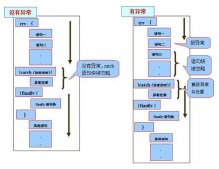静态变量初始化顺序
1.简单规则
首先先看一段最普遍的JAVA代码:
|
1
2
3
4
5
6
7
8
9
10
11
12
13
14
15
16
17
18
19
20
21
|
public class Test{ public static Test1 t = new Test1(); public static int a = 0; public static int b; public static void main(String[] arg) { System.out.println(Test.a); System.out.println(Test.b); }}class Test1{ public Test1() { Test.a++; Test.b++; }} |
这里先猜下控制台输出结果是什么?
OK, 或许你已经猜到下面了结果了,那么你还是熟悉Java的。
如果你不明白是为什么会输出上面的结果,那么我来告诉你。
Java静态变量初始化遵循以下规则:
-
静态变量会按照声明的顺序先依次声明并设置为该类型的默认值,但不赋值为初始化的值。
-
声明完毕后,再按声明的顺序依次设置为初始化的值,如果没有初始化的值就跳过。
看了这个就会明白,原来Test.a的值变化了三次。
声明时设置为0>>Test1::Test1里设置为1>>Test.a初始化为0
2.复杂规则
明白了这个,请再看下面的代码。
|
1
2
3
4
5
6
7
8
9
10
11
12
13
14
15
16
17
18
19
20
21
22
23
24
25
26
27
28
29
30
31
32
33
34
35
36
37
38
39
40
41
42
43
44
45
46
47
48
49
50
51
52
53
54
55
56
|
public class A{ public static int b = B.a; public static A plus =new A("A"); public static final int finalInt = (int)(Math.random()*100); public static B p = new B("A"); public static final String finalStr = "finalStr"; public static final Integer finalInteger = new Integer(10); public static int a = 1; public static B c = null; public A(String from) { System.out.println("----------- begin A::A ----------------"); System.out.println("A::A, from="+from); System.out.println("A::A, A.b="+A.b); System.out.println("A::A, A.finalInt="+A.finalInt); System.out.println("A::A, B.a="+B.a); System.out.println("A::A, B.plus="+B.plus); System.out.println("----------- end A::A ----------------"); } public static void main(String[] arg) { System.out.println("main, A.b="+A.b); System.out.println("main, B.t="+B.t); System.out.println("main, C.a="+C.a); }}class B{ public static int t = A.a; public static A plus = new A("B"); public static int a = 1; public B(String from) { System.out.println("----------- begin B::B ----------------"); System.out.println("B::B, from="+from); System.out.println("B::B, B.a="+B.a); System.out.println("B::B, A.a="+A.a); System.out.println("B::B, A.p="+A.p); System.out.println("B::B, A.plus="+A.plus); System.out.println("B::B, A.finalInt="+A.finalInt); System.out.println("B::B, A.finalInteger="+A.finalInteger); System.out.println("B::B, A.finalStr="+A.finalStr); System.out.println("----------- end B::B ----------------"); }}class C{ public static final A a = new A("C");} |
这个你还能猜到输出结果吗? 我是在一边测试一边写的,所以我没猜出来.哈哈
控制台输出结果为:
|
1
2
3
4
5
6
7
8
9
10
11
12
13
14
15
16
17
18
19
20
21
22
23
24
25
26
27
28
29
30
31
32
33
34
|
----------- begin A::A ----------------A::A, from=BA::A, A.b=0A::A, A.finalInt=0A::A, B.a=0A::A, B.plus=null----------- end A::A --------------------------- begin A::A ----------------A::A, from=AA::A, A.b=1A::A, A.finalInt=0A::A, B.a=1A::A, B.plus=A@a90653----------- end A::A --------------------------- begin B::B ----------------B::B, from=AB::B, B.a=1B::B, A.a=0B::B, A.p=nullB::B, A.plus=A@1fb8ee3B::B, A.finalInt=61B::B, A.finalInteger=nullB::B, A.finalStr=finalStr----------- end B::B ----------------main, A.b=1main, B.t=0----------- begin A::A ----------------A::A, from=CA::A, A.b=1A::A, A.finalInt=61A::A, B.a=1A::A, B.plus=A@a90653----------- end A::A ----------------main, C.a=A@61de33 |
这个结果你没猜到吧,哈哈.
要一句一句的讲解程序执行结果,还是要很到的篇幅的.这里就直接写出Java静态变量初始化遵循的规则了。
第一段的规则依然有效,只是不健全。
-
只有主动请求一个类,这个类才会初始化,仅包含静态变量,函数,等静态的东西.
-
继承关系时,先初始化父类,后初始化子类.
-
静态变量会按照声明的顺序先依次声明并设置为该类型的默认值,但不赋值为初始化的值.
-
声明完毕后,再按声明的顺序依次设置为初始化的值,如果没有初始化的值就跳过.
-
当初始化A.b=B.a时,暂停初始化A.b,设置当前类为B,跳到步骤3,并执行.
-
当初始化B.plus = new A时,暂停初始化B.plus,实例化A并赋值给B.plus.
-
当A的构造函数里需要获得B.a的值时,B.a还初始化并处于暂停初始化状态,直接取B.a的当前值,不再等待B.a初始化.
-
final,静态常量其实是遵循普通静态变量的初始化的,但是在编译时,编译器会将不可变的常量值在使用的地方替换掉.可以用Java反编译工具查看.
static数据的初始化
加上static限定的字段,是所谓的类字段,也就是说这个字段的拥有者不是对象而是类。无论创建多少对象,static数据都只有一份。
类内总是先初始化static字段,再初始化一般字段。接着初始化构造器。但是如果不创建这个类的对象,那这个对象是不会进行初始化的,并且只执行一次。
如下面的代码,在StaticInitialization类中,先初始化static Table table = new Table();,然后才去初始化Table对象,不然是不会被初始化的。
|
1
2
3
4
5
6
7
8
9
10
11
12
13
14
15
16
17
18
19
20
21
22
23
24
25
26
27
28
29
30
31
32
33
34
35
36
37
38
39
40
41
42
43
44
45
46
|
class Bowl { Bowl(int marker) { print("Bowl(" + marker + ")"); } void f1(int marker) { print("f1(" + marker + ")"); }}class Table { static Bowl bowl1 = new Bowl(1); Table() { print("Table()"); bowl2.f1(1); } void f2(int marker) { print("f2(" + marker + ")"); } static Bowl bowl2 = new Bowl(2);}class Cupboard { Bowl bowl3 = new Bowl(3); static Bowl bowl4 = new Bowl(4); Cupboard() { print("Cupboard()"); bowl4.f1(2); } void f3(int marker) { print("f3(" + marker + ")"); } static Bowl bowl5 = new Bowl(5);}public class StaticInitialization { public static void main(String[] args) { print("Creating new Cupboard() in main"); new Cupboard(); print("Creating new Cupboard() in main"); new Cupboard(); table.f2(1); cupboard.f3(1); } static Table table = new Table(); static Cupboard cupboard = new Cupboard();} |
输出:
|
1
2
3
4
5
6
7
8
9
10
11
12
13
14
15
16
17
18
19
|
Bowl(1)Bowl(2)Table()f1(1)Bowl(4)Bowl(5)Bowl(3)Cupboard()f1(2)Creating new Cupboard() in mainBowl(3)Cupboard()f1(2)Creating new Cupboard() in mainBowl(3)Cupboard()f1(2)f2(1)f3(1) |
显示的静态初始化(也就是静态块)
把多个初始化语句包在一个static花括号里,叫做静态块,其实就是把多个static合在一起写了,本质是一样的。只有首次创建对象或者首次访问类的字段时才会执行,而且仅仅一次。
|
1
2
3
4
5
6
7
8
9
10
11
12
13
14
15
16
17
18
19
20
21
22
23
24
25
26
27
28
29
|
class Cup { Cup(int marker) { print("Cup(" + marker + ")"); } void f(int marker) { print("f(" + marker + ")"); }}class Cups { static Cup cup1; static Cup cup2; static { cup1 = new Cup(1); cup2 = new Cup(2); } Cups() { print("Cups()"); }}public class ExplicitStatic { public static void main(String[] args) { print("Inside main()"); Cups.cup1.f(99); // (1) } // static Cups cups1 = new Cups(); // (2) // static Cups cups2 = new Cups(); // (2)} |
输出:
|
1
2
3
4
|
Inside main()Cup(1)Cup(2)f(99) |
非静态实例初始化
这个没什么好讲的,就是普通初始化,按顺序执行,可以多次执行。
|
1
2
3
4
5
6
7
8
9
10
11
12
13
14
15
16
17
18
19
20
21
22
23
24
25
26
27
28
29
30
31
|
class Mug { Mug(int marker) { print("Mug(" + marker + ")"); } void f(int marker) { print("f(" + marker + ")"); }}public class Mugs { Mug mug1; Mug mug2; { mug1 = new Mug(1); mug2 = new Mug(2); print("mug1 & mug2 initialized"); } Mugs() { print("Mugs()"); } Mugs(int i) { print("Mugs(int)"); } public static void main(String[] args) { print("Inside main()"); new Mugs(); print("new Mugs() completed"); new Mugs(1); print("new Mugs(1) completed"); }} |
|
1
2
3
4
5
6
7
8
9
10
11
|
Inside main()Mug(1)Mug(2)mug1 & mug2 initializedMugs()new Mugs() completedMug(1)Mug(2)mug1 & mug2 initializedMugs(int)new Mugs(1) completed |













